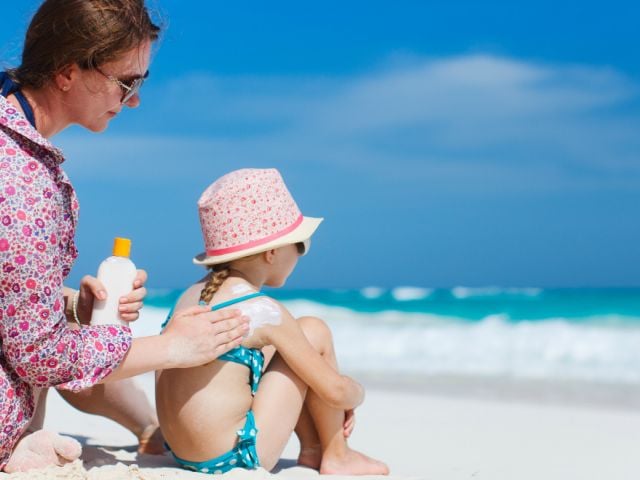
Fall is the iconic American season. Football. Soccer. Cross-country meets. Apple-picking. Hiking through forests blazing red and orange. Bicycling in crisp country air. Raking the leaves. Hayrides. Pumpkin patches. School fairs.
And as temperatures drop and bathing suits go into the bottom drawer, thoughts of sun protection fade away with summer's tans. We stop worrying about getting too much sun, because we're not broiling on the beach.
That's a mistake.
Although sunburn-causing ultraviolet B (UVB) radiation strikes the ground with less intensity when the sun rides lower in the sky, the bombardment of ultraviolet A (UVA) changes less throughout the year. Those UVA rays don't leave us looking red and feeling hot, but they are more prevalent than UVB rays and penetrate deeper into uncovered skin, posing a serious and insidious threat to human health.
Savvy consumers know they still need to protect their skin when fall comes -- but there's a catch. Most of the sunscreens on the U.S. market today offer woefully weak protection against relentless but subtle UVA rays.
A new Environmental Working Group (EWG) analysis of 446 beach and sport sunscreens with SPF ratings of 30+ found that nearly two-thirds of them provide inadequate UVA protection. Those 284 products are too weak for the European market, where manufacturers voluntarily comply with a European Union recommendation that all sunscreens provide meaningful UVA protection in relation to the sunburn protection factor (SPF), a measure of the product’s ability to shield against UBV rays.
Why UVA Protection Matters
Until the mid 1990's when FDA called a public meeting on UVA protection, sunscreen manufacturers and regulatory officials paid little attention to UVA protection (FDA 1994). Meanwhile, in the 1990s and early 2000s, scientists repeated and verified experiments from the 60's and 70's showing UVA-induced damages, this time with more accurate scientific instrumentation.(Giacomoni 2005) Among the dangers noted by researchers:
- UVA radiation suppresses the immune system, ages skin, harms connective tissue and elevates the risk of the deadly skin cancer melanoma (Cadet 2009, Draelos 2010, IARC 2009; FDA 2007a, Garland 2003, Godar 2009, Gorham 2007).
- A lot more UVA rays than UVB rays blast us daily. Because the earth's ozone layer absorbs most UVB rays, somewhere between 90 and 99 percent of the ultraviolet light that reaches people is UVA radiation (Johnson 1976, Seckmeyer 2008).
- Sunburns are rare in the fall as UVB radiation drops off. But UVA rays continue to bombard your skin through the fall. By mid-October your chances of getting sunburned by UVB rays drop by about two-thirds, but you are being still exposed to half the UVA radiation of a mid-summer day (Johnson 1976, Seckmeyer 2008).
- Being inside doesn't always protect you. UVA radiation penetrates glass. A study by US Food and Drug Administration scientists suggests that UVA exposure through windows may be the reason for an observed increase in melanoma skin cancer among office workers (Godar 2009).
- The International Agency for Research on Cancer (IARC) deems UVA rays to be "carcinogenic to humans" and points to evidence that people who have used UVA-intensive tanning beds have an increased risk of melanoma (IARC 2006). The precise mechanism by which UVA and UVB rays cause melanoma is not understood. However melanoma rates are increasing faster than any other types of skin cancer and have increased by a factor of 3 since the mid 70's (NCI 2009).
We can be sure of this much: Overexposure to harmful sun radiation is an avoidable risk. Many experts strongly recommend that people cover up and avoid exposure to direct sun for long periods – including the sunlight that streams through office windows and vehicles (Autier 2009, Godar 2009, Gorham 2007).
U.S. Consumers Have Few Options for UVA Protection
EWG has determined that only one-third of high SPF products offer strong protection against both UVA and UVB rays, making U.S. sunscreens worse overall than those sold abroad. Despite claims on sunscreen labels, there's no such thing as an all-day, sweat-proof, waterproof sun block. Similarly, many products advertise but do not actually provide "broad spectrum" sun protection. A product survey by sunscreen maker Proctor & Gamble in 2004 noted that a third of products that claimed broad spectrum protection on the label didn't actually provide it (Nash 2004).

A major obstacle to progress is the federal Food and Drug Administration, which has never managed to sign, seal and deliver the sunscreen regulations it began developing in 1978. The latest draft of those rules was issued in 2007 but ended up in regulatory limbo, where it remains (FDA 2007).
Even though it can't seem to close the deal on its regulation, the FDA insists that manufacturers who make sunscreens for the American market stick to a list of 17 ingredients. A rule issued in 1999 and never updated limits concentrations and combinations (FDA 1999).
EWG's analysis of beach and sport sunscreens shows that because of FDA's limits on sunscreen ingredients, not a single product sold on the U.S. market this year would achieve FDA's proposed highest rating for UVA protection – four stars.
By contrast, sunscreen makers catering to the European market can choose among 28 active ingredients. EWG's analysis showed that many European sunscreens would achieve four-star ratings under the proposed FDA system. Five years ago some U.S. sunscreen makers began seeking FDA approval to use some of these compounds. They are still waiting.
That's a crucial lapse when it comes to UVA protection, because seven compounds that effectively block UVA are available for use in Europe, but only three in the United States. Among the UVA filters approved in Europe are three – Tinosorb S, Tinosorb M and Mexoryl SX – that are between 3.8 times and 5.1 times more protective than the maximum allowable concentration of Avobenzone, the most common UVA filter in the U.S. products (BASF-Ciba 2010).
Tinosorb S and Tinosorb M, used in European compounds for a decade, appear to be relatively non-toxic, according to manufacturer data provided to the European Union and FDA (Ciba 2000).
The available data for Mexoryl SX, on the market in Europe since 1991, does not raise toxicity concerns, EWG's analysis has found. FDA has not approved it for general use but has permitted L'Oréal to use it in a small number of products sold under its "LaRoche-Posay" and "Kiehl's" brands, where it is called "Ecamsule."
FDA's delays in complete its safety and effectiveness reviews of these UVA filtering ingredients creates a Catch-22 for manufacturers who might want to adopt the proposed FDA rating system, because no U.S. product can currently achieve four stars (Osterwalder 2009b, FDA 2007). The prospects for voluntary compliance would likely improve, should FDA remove this roadblock by approving more modern ingredients or lifting restrictions on sunscreen concentrations and combinations.
In the absence of solid, up-to-date regulations, sunscreen makers get away with making unsubstantiated marketing claims that their products offer "broad spectrum UVA and UVB protection" -- because they can. Ad hype can soar as sky-high as bogus SPF numbers.
The agency projects that its proposed rule for UVA screen testing and labeling, issued August 2007, could be finalized as early as October 2010 (Reginfo 2010). But even if the agency meets that deadline – and there are no guarantees – the rule would not likely go into force for at least two more summers.
Proposed UVA Rating System Is a Step Forward
EWG's analysis found that the agency's proposal has some positive features: a reasonably simple rating scheme that would classify label product's UVA protection from zero stars ("no protection") to four stars ("very high protection"). But it has some drawbacks.
The proposed FDA rule merely requires disclosure of UVA protection offered by a sunscreen. Under these rules it will still be legal to sell a product with zero stars, which offers no UVA protection.

Source: FDA's Consumer Guide (FDA 2007b)
Click to enlarge
Some critics argue that listing UVA and UVB protection separately will confuse customers who will chose amongst products with 16 different possible combinations of low, med, high and very high protection from UVA and UVB rays (Osterwalder 2009a). This is especially true in the United States, where many sunscreens offer extremely high protection from sunburn but minimal UVA protection.
Europe has sidestepped both of these issues by requiring all sunscreens to have a baseline level of UVA protection that is roughly equivalent to a three star product in the FDA's proposed scheme. This allows consumers to select a product that provides adequate sunburn protection based on their skin tone and intensity of sun exposure, and at the same time, to be assured that the product protects against UVA rays as well.
Another criticism is that the FDA approach requires blocking against all UVA rays instead of targeting those parts of the UVA spectrum that actually cause harm by provoking damages like free radicals or melanoma. EWG would support this approach when science establishes appropriate health-relevant metrics.
The regulatory vacuum leaves consumers in the dark about how much protection their sunscreens really offer against UVA rays. EWG believes that despite its imperfections, the FDA proposal would go a long way toward filling this gap. The agency has asked sunscreen makers to adopt the proposed star-based rating system while the regulatory system grinds to a conclusion (FDA 2007), but so far no company has done so.
To demonstrate how that system would work, EWG analyzed this year's leading sunscreens with SPF 30 or higher to determine how they would stack up if the FDA's star ratings were in force today. The analysis showed that:
- Neutrogena products offered the highest average UVA protection, at nearly three stars, while Panama Jack offered the lowest, at two stars, considered "medium" protection.
- More than half of all sunscreens with "high" SPFs (30 or greater) offered only "low" or "medium" UVA protection. This means that people using products advertising "broad spectrum" UVA/UVB protection may still be exposing their skin to excess, damaging UVA radiation.
- At least seven popular products that were labeled in 2010 with "high" sunburn protection (SPF>=30) provided only low, one-star UVA protection.
| Products offering "high SPF" but only one-star ("low") UVA protection: | |
|---|---|
| Banana Boat | Ultra Sunblock Lotion, SPF 30+ |
| Coppertone | Sport Continuous Spray, SPF 30 |
| Fruit of the Earth | Block Up! Sunscreen Lotion with Aloe Vera, SPF 30 |
| Panama Jack | Kids Sunscreen Lotion, SPF 30 |
| Surf 'N Sport Continuous Clear Spray Sunscreen, SPF 30 | |
| Continuous Clear Spray Sunscreen, SPF 30 * | |
| Sunscreen Lotion, SPF 30 | |
Source: EWG analysis of sunscreen ingredients using FDA's proposed UVA rating methodology, standard sunscreen industry UV absorbance model, and information on sunscreen efficacy and UV-induced skin damage from the published scientific literature.
- Major sunscreen brands vary widely in the amount of UVA protection they provide. Based on the labeled ingredients, EWG estimated each product's UVA protection rating under FDA's proposed star system. It found that among sunscreens with SPF 30 or higher, Neutrogena products offer the highest average UVA protection, at nearly three stars, while Panama Jack offers the lowest, at two stars.
| Sunscreen Brand | Average Estimated UVA star rating | Number of high SPF sunscreens assessed (SPF >=30) |
|---|---|---|
| Neutrogena |     (2.9) (2.9) |
40 |
| Coppertone |     (2.7) (2.7) |
43 |
| Banana Boat |     (2.6) (2.6) |
36 |
| CVS |     (2.6) (2.6) |
20 |
| Hawaiian Tropic |     (2.6) (2.6) |
18 |
| Ocean Potion |     (2.5) (2.5) |
17 |
| Solar Sense |     (2.4) (2.4) |
12 |
| Baby Blanket |     (2.3) (2.3) |
12 |
| Alba Botanica |     (2.3) (2.3) |
10 |
| Panama Jack |     (2.0) (2.0) |
15 |
These differences matter. BASF-Ciba's noted sunscreen researcher Uli Osterwalder has estimated that a product earning four stars under the FDA proposal would shield skin from UVA damage 10 times more effectively than a one-star product (Osterwalder 2009b).
Most one- and two-star sunscreens would not even be on the market in Europe. Since 2008, European manufacturers have voluntarily complied with European Union recommendations that all products provide minimum level of UVA protection that is roughly equivalent to a three-star or "high" rating in the proposed FDA system (European Commission 2006, Colipa 2008, Osterwalder 2010).
The American Academy of Dermatology (AAD) has endorsed the European approach, advocating that UVA protection be at least one-third of the SPF rating (as measured by a test for pigment darkening), with a minimum level of UVA protection (AAD 2008).
EWG is not the only organization to rate sunscreens, but it is the only one to apply the proposed FDA star-rating system. The Skin Care Foundation, which charges manufacturers makers a $10,000 fee to be considered for its "Seal of Recommendation," does not evaluate UVA protection of recommended sunscreens (SCF 2010). EWG's analysis of UVA protection for 100 sunscreens that bear the Foundation's Seal of Recommendation found that 39 provide only one- or two-star UVA protection.
Consumers will benefit from clear disclosure of UVA protection on product labels. FDA has asked manufacturers to comply voluntarily with its proposed star system and with other aspects of the proposed sunscreen rules. Accordingly, in 2011 EWG plans to broaden its annual sunscreen guide to reflect not only the level of UVA protection each product provides, but also whether the company is using the four-star labeling system. Until the FDA acts, consumers can use EWG's impartial sunscreen guide to find products that provide real broad-spectrum protection, full disclosure and few ingredients that pose other kinds of health risks.
EWG has published annual ratings for sunscreens since 2007, considering UVB and UVA protection and potential hazards of ingredients that soak through the skin. These ratings are based on EWG's conviction that consumers have the right to full information on both UVA and UVB protection.
EWG also makes these recommendations:
- Sunscreen manufacturers must provide consumers with products that offer the best available protection against sun damage and skin cancer. Low and moderate protection from UVA is unacceptable in high SPF sunscreens.
- FDA should finalize its draft sunscreen rules, first published in 1978. The agency's unkept promises to complete the rules are unacceptable and represent a failure in public health policy.
- The FDA must expedite its reviews of chemicals that promise to perform as better UVA filters and promptly approve those ingredients that can be safely added to sunscreens.
- Industry should invest more heavily in developing new and better UVA filters that do not pose toxic risks.
- Congress should appropriate funds to support independent research to provide consumers with unbiased studies on the causes of skin cancer and sunscreen effectiveness and risks.
- The Skin Cancer Foundation should immediately withdraw its endorsement of products that do not provide strong UVA protection.
Once truly safe and effective UVA filters come on the American market, we can enjoy fall's simple pleasures – tailgate picnics, sidewalk cafes, all-day kayak trips – assured that we're doing right by our skin.

